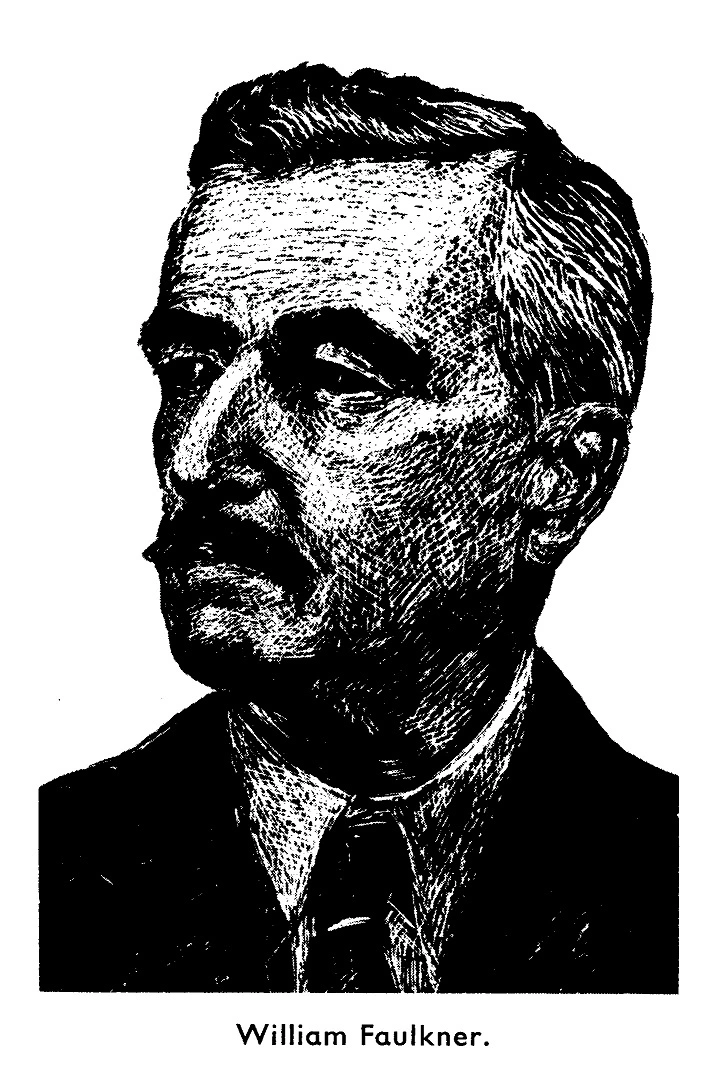William Faulkner I INTRODUCTION William Faulkner Twentieth-century American novelist William Faulkner wrote novels that explored the tensions between the old and the new in the American South.
Publié le 12/05/2013

Extrait du document


«
Faulkner’s “powerful and artistically unique contribution to the modern American novel.” He also wrote numerous short stories, many of the best of which werepublished in book form in Go Down, Moses (1942) and The Collected Stories (1950; Pulitzer Prize, 1951).
In-between his fiction works, which until late in his career did not always pay well, Faulkner wrote screenplays for Hollywood; two of his more prominent scripts were for the motion pictures To Have and Have Not (1944) and The Big Sleep (1946), both directed by Howard Hawks.
III WORKS
Faulkner often described himself as 'just a farmer who likes to tell stories.' His style, however, was that of a consummately skilled craftsman.
His luxuriant prose styleand complicated plot structure make some of his works difficult to read.
Despite the intricacy of his technique, Faulkner was a wonderful storyteller, and his comic sensematched his understanding of the tragic.
The language of his characters is based on popular Southern speech, and can be foul, funny, brilliantly metaphorical, savage,evil, and exciting.
Although he wrote almost exclusively about the South he was not a regional novelist, instead examining universal themes of concern to all humanity.Particularly in his later works, Faulkner stressed man's power to prevail over evil and decay and to find new values when the traditional ones have failed.
In the novel Sartoris Faulkner introduced a fictional territory in Mississippi called Yoknapatawpha County, which was closely modeled on the author’s own county of Lafayette.
This legendary region became the setting for most of his later works, to the point where he even created a map of it for inclusion with his books on which helisted himself as the region’s “sole owner and proprietor.” The county’s inhabitants are drawn from every level of Southern society, ranging from the Sartoris family,symbols of the once-powerful landed aristocracy, to the Snopes family, unprincipled lower-class exploiters of the South.
These two families and other characters appearagain and again in Faulkner's works.
In The Sound and the Fury , often regarded as Faulkner’s finest novel, he portrayed the decline of another aristocratic family, the Compsons.
The emotional intensity of this novel is heightened by the technique of allowing the main characters to tell the story in internal monologues that reflect their own disordered—and sometimes eveninsane—point of view.
Another of Faulkner’s important early novels is As I Lay Dying, about a poor family fulfilling a mother’s last wish to be buried in the family plot, which leads the family members on a difficult journey.
After writing a novel that he later claimed was designed strictly to generate financial return ( Sanctuary, 1931), Faulkner resumed his literary efforts.
In 1936 he published Absalom, Absalom! , one of his most powerful novels.
The book is the story of the Sutpen family and its patriarch, Thomas Sutpen, who forged a plantation out of the Mississippi wilderness in the mid-19th century.
A few years after this novel came The Hamlet (1940), the first in a trilogy of humorous novels about the Snopes family.
The other two books in the trilogy are The Town and The Mansion .
Among Faulkner’s most remarkable short stories is “A Rose for Emily” (1931), which contains elements of the author’s common theme of the decline of the old South.Go Down, Moses, a volume of stories about the McCaslin family, includes the author’s well-known novella “The Bear.” Another story that would later be anthologized as a Faulkner classic is “That Evening Sun” (1931), which also features the Compson family.
Faulkner's works demanded much of his readers.
To create a mood, he might let one of his complex sentences run on for more than a page.
He juggled time, splicednarratives, experimented with multiple narrators, and interrupted simple stories with rambling, stream-of-consciousness soliloquies.
Although hailed as a genius,Faulkner acquired a reputation as a difficult author to read.
American critic Malcolm Cowley, concerned that the writer was insufficiently known and appreciated, puttogether The Portable Faulkner (1946).
This book arranged excerpts from Faulkner’s novels into a chronological sequence that gave the entire Yoknapatawpha saga a new clarity.
The collection made Faulkner's work accessible to a new generation of readers.
For the last few years of his life, Faulkner was a writer in residence and lecturer in American literature at the University of Virginia.
However, he continued to spendmuch of his time at his home in Oxford.
In 1962 he was awarded the gold medal of the American Academy of Arts and Letters.
His last novel, The Reivers , was published shortly before his death the same year.
Selected Letters of William Faulkner , edited by Joseph Blotner, was issued in 1977.
Microsoft ® Encarta ® 2009. © 1993-2008 Microsoft Corporation.
All rights reserved..
»
↓↓↓ APERÇU DU DOCUMENT ↓↓↓
Liens utiles
- Ernest Hemingway I INTRODUCTION Ernest Hemingway Twentieth-century American author Ernest Hemingway wrote novels and stories that reflected his rich life experiences as a war correspondent, outdoor sportsman, and bullfight enthusiast.
- Mesopotamian Art and Architecture I INTRODUCTION Mesopotamian Art and Architecture, the arts and buildings of the ancient Middle Eastern civilizations that developed in the area (now Iraq) between the Tigris and Euphrates rivers from prehistory to the 6th century BC.
- Wolfgang Amadeus Mozart I INTRODUCTION Wolfgang Amadeus Mozart Wolfgang Amadeus Mozart, an 18th-century Austrian classical composer and one of the most famous musicians of all time, came from a family of musicians that included his father and sister.
- Nathaniel Hawthorne I INTRODUCTION Nathaniel Hawthorne (1804-1864), American novelist, whose works are deeply concerned with the ethical problems of sin, punishment, and atonement.
- Walter Gropius Walter Gropius (1883-1969), German American architect and educator, who founded the Bauhaus, a German art school that became a seminal force in architecture and applied art during the first half of the 20th century.

































